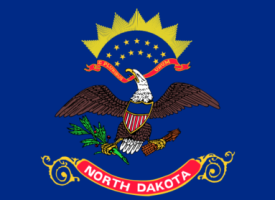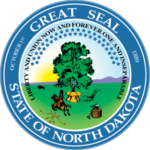North Dakota
North Dakota is a state located in the Upper Midwestern region of the United States. It is bordered by Canada to the north, the states of Minnesota to the east, South Dakota to the south, and Montana to the west.
- ABBREVIATION: ND
- NICKNAME: The Rough Rider State
- POPULATION: 723,393 (2013 est.)
- CAPITAL: Bismarck
- STATE BIRD: Western Meadowlark
- STATE FLOWER: Wild Prairie Rose
- AREA: 70,700 sq. mi.
- TIME ZONE: Most of state: Central – southwest: Mountain
- ENTERED UNION: Nov. 2, 1889
- ALTITUDE: High, 3,508 ft. White Butte
- CLIMATE: Generally severe winters, short hot summers. Predominately semi-arid and subject to droughts; moderate rainfall in the southeast.


The central point of North America lies in North Dakota-Approximately 1,500 miles equidistant from the Atlantic, the Pacific, the Gulf of Mexico, and the Artic Archipelago. Here is a land of vivid colors and contrasting forms. The northern Red River Valley, once the bed of an ancient glacial lake, is one of the most fertile agricultural regions in the nation. On the valley’s rich black soil rolls a yellow ocean of spring wheat, speckled here and there with blue fields of flax, from which linseed oil is extracted. In flax production North Dakota leads the nation, it comes in second for production of spring wheat.
On the state’s central drift plain, spotted with salt lakes, grain crops like barley, rye, and durum wheat flourish. In the west are the Dakota Badlands, so called because they often impeded early travelers with treacherously sandy soils and weirdly eroded sandstone buttes. But now the Badlands have a symbolic value. They roof a part of the vast Williston Basin, an underground treasure house of petroleum and potash resources. As one prospector said in 1952, shortly after the riches were discovered, “it’s not just one oil field, it’s an oil province”.

With its limited amount of rainfall, North Dakota has always had a water shortage. Although the rich land can be extremely productive, it is so sensitive to variations in annual rainfall that the wheat harvest can fluctuate wildly, however, agriculture is still the largest industry in North Dakota. It is currently the fastest-growing state in U.S. by GDP, this is mostly because of increased production in the oil and gas industries; as of May 2014, the state’s unemployment rate is the lowest in the nation at 2.6%. The oil and natural gas industries in North Dakota provide about 64,000 jobs—12 percent of the state’s total employment.
FUN FACTS:
- Sunflowers grow as tall as 13 feet in North Dakota.
- Each year a demolition derby using farm combines is held at the State Fair in Minot.
- Devils Lake, the largest natural body of water in North Dakota, is known among fishermen as the Perch Capital of the World.
- More waterfowl hatch in the many prairie kettle hole and sloughs of North Dakota than in any other state.
- A bronze statue of Sakakawea and her baby son Jean Baptiste stands at the entrance to the North Dakota Heritage Center on the grounds of the state capitol in Bismark.
- Explorers William Clark and Meriwether Lewis and the Corps of Discovery spent more time in what is now North Dakota than any other place on their journey.
